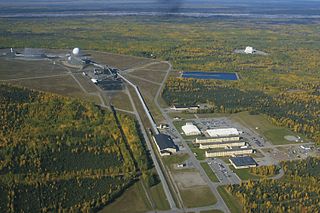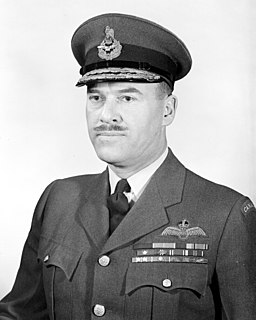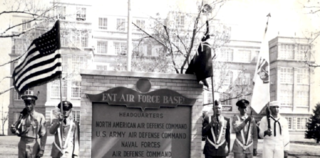Related Research Articles

North American Aerospace Defense Command, known until March 1981 as the North American Air Defense Command, is a combined organization of the United States and Canada that provides aerospace warning, air sovereignty, and protection for Canada and the continental United States. Headquarters for NORAD and the NORAD/United States Northern Command (USNORTHCOM) center are located at Peterson Space Force Base in El Paso County, near Colorado Springs, Colorado. The nearby Cheyenne Mountain Complex has the Alternate Command Center. The NORAD commander and deputy commander (CINCNORAD) are, respectively, a United States four-star general or equivalent and a Canadian Lieutenant-general or equivalent.

The Defense Information Systems Agency (DISA), known as the Defense Communications Agency (DCA) until 1991, is a United States Department of Defense (DoD) combat support agency composed of military, federal civilians, and contractors. DISA provides information technology (IT) and communications support to the President, Vice President, Secretary of Defense, the military services, the combatant commands, and any individual or system contributing to the defense of the United States.

The Cheyenne Mountain Complex is a Space Force installation and defensive bunker located in unincorporated El Paso County, Colorado, next to the city of Colorado Springs, at the Cheyenne Mountain Space Force Station, which hosts the activities of several tenant units. Also located in Colorado Springs is Peterson Space Force Base, where the North American Aerospace Defense Command (NORAD) and United States Northern Command (USNORTHCOM) headquarters are located.

PAVE PAWS is a complex Cold War early warning radar and computer system developed in 1980 to "detect and characterize a sea-launched ballistic missile attack against the United States". With the first solid-state phased array deployed, the system used a pair of Raytheon AN/FPS-115 phased array radar sets at each site to cover a wide azimuth angle of 240 degrees. Two sites were deployed in 1980 at the periphery of the contiguous United States, then two more in 1987–95, as part of the United States Space Surveillance Network. One system was sold to Taiwan and is still in service.

The defense readiness condition (DEFCON) is an alert state used by the United States Armed Forces.

The RCA 474L Ballistic Missile Early Warning System was a United States Air Force Cold War early warning radar, computer, and communications system, for ballistic missile detection. The network of twelve radars, which was constructed beginning in 1958 and became operational in 1961, was built to detect a "mass ballistic missile attack launched on northern approaches [for] 15 to 25 minutes' warning time" also provided Project Space Track satellite data.

United States Strategic Command (USSTRATCOM) is one of the eleven unified combatant commands in the United States Department of Defense. Headquartered at Offutt Air Force Base, Nebraska, USSTRATCOM is responsible for strategic nuclear deterrence, global strike, and operating the Defense Department's Global Information Grid. It also provides a host of capabilities to support the other combatant commands, including integrated missile defense; and global command, control, communications, computers, intelligence, surveillance, and reconnaissance (C4ISR). This command exists to give national leadership a unified resource for greater understanding of specific threats around the world and the means to respond to those threats rapidly.

Clear Space Force Station is a United States Space Force radar station for detecting incoming ICBMs and submarine-launched ballistic missiles to NORAD's command center and to provide Space Surveillance data to the United States Space Force. Clear's AN/FPS-123 Upgraded Early Warning Radar is part of the Solid State Phased Array Radar System (SSPARS) which also includes those at Beale AFB, Cape Cod Space Force Station, RAF Fylingdales and Thule Site J. The "historic property" was one of the Alaska World War II Army Airfields and later a Cold War BMEWS site providing NORAD data to Colorado's BMEWS Central Computer and Display Facility (CC&DF).

The National Military Command Center (NMCC) is a Pentagon command and communications center for the National Command Authority. Maintained by the Department of the Air Force as the "DoD Executive Agent" for NMCC logistical, budgetary, facility and systems support; the NMCC operators are in the Joint Staff's J-3 (Operations) Directorate. "The NMCC is responsible for generating Emergency Action Messages (EAMs) to missile launch control centers, nuclear submarines, recon aircraft and battlefield commanders".
The Worldwide Military Command and Control System, or WWMCCS, was a military command and control system implemented for the command and control of the United States military. It was created in the days following the Cuban Missile Crisis. WWMCCS was a complex of systems that encompassed the elements of warning, communications, data collection and processing, executive decision-making tools and supporting facilities. It was decommissioned in 1996 and replaced by the Global Command and Control System.

The Raven Rock Mountain Complex (RRMC), also known as Site R, is a U.S. military installation with an underground nuclear bunker near Blue Ridge Summit, Pennsylvania, at Raven Rock Mountain that has been called an "underground Pentagon". The bunker has emergency operations centers for the United States Army, Navy, Air Force and Marine Corps. Along with Mount Weather Emergency Operations Center in Virginia and the Cheyenne Mountain Complex in Colorado, it formed the core bunker complexes for the US continuity of government plan during the Cold War to survive a nuclear attack.
The IBM AN/FSQ-31 SAC Data Processing System was a USAF command, control, and coordination system for the Cold War Strategic Air Command (SAC). IBM's Federal Systems Division was the prime contractor for the AN/FSQ-31s, which were part of the TBD 465L SAC Automated Command and Control System (SACCS), a "Big L" system of systems (cf. 416L SAGE & 474L BMEWS( which had numerous sites throughout the Continental United States: "all SAC command posts and missile LCC's", a communication network, etc.; and the several FSQ-31 sites including:

Air Marshal Charles Roy Slemon, CB, CBE, CD, known as Roy Slemon, was the Royal Canadian Air Force's Chief of the Air Staff from 1953 to 1957. In 1957 he was appointed as the first Deputy Commander of NORAD.
The National Program Office (NPO) was an office of the United States Government, established to ensure continuity of government in the event of a national disaster. The NPO was established by a secret executive order signed on 14 September 1982 by President Ronald Reagan during the Cold War in preparation for a nuclear war, presumably with the Soviet Union.

The Chidlaw Building is a former United States Air Force facility located in the Knob Hill neighborhood of Colorado Springs, Colorado. The building was close to, but not within, the Ent Air Force Base complex, and was leased by the military for several decades, housing headquarters for several military commands, starting with the Air Defense Command (ADC) and the North American Aerospace Defense Command (NORAD). When Chidlaw was completed, personnel from multiple locations, including the Ent Air Force Base, were consolidated into the new building.
The GE AN/GPA-37 Course Directing Group was a USAF Cold War air defense command, control, and coordination system for weapons direction. During Air Defense Command's "Control Capability Improvement Program" to improve command guidance of manned aircraft, the AN/GPA-37 was "developed by the General Electric Heavy Military Electronic Equipment Department at Syracuse in conjunction with...Rome Air Development Center and the Electronics Research Laboratories of Columbia University." Used to process radar data, the system was to "track a potential enemy aircraft and direct intercepters [sic] into a position from which they can make their automatic firing runs", the system included the:
The IBM 473L Command and Control System was a USAF Cold War "Big L" Support System with computer equipment at The Pentagon and, in Pennsylvania, the Alternate National Military Command Center nuclear bunker. Each 473L site included a Data Processing Subsystem (DPSS), Integrated Console Subsystem (ICSS), Large Panel Display Subsystem, and Data Communications Subsystem. The "System 473L" was an "on-line, real-time information processing system designed to facilitate effective management of USAF resources, particularly during emergency situations" e.g., for: "situation monitoring, resource monitoring, plan evaluation, plan generation and modification, and operations monitoring". In 1967, the 473L System was used during the "HIGH HEELS 67" exercise "to test the whole spectrum of command in a strategic crisis".
Iconorama was a Cold War electronic projection system for graphic presentation developed by the firm Fenske, Fedrick and Miller. The Iconorama was ordered by the United States Air Force in 1959.

Continental Air Defense Command (CONAD) was a Unified Combatant Command of the United States Department of Defense, tasked with air defense for the Continental United States. It comprised Army, Air Force, and Navy components. It included Army Project Nike missiles anti-aircraft defenses and USAF interceptors. The primary purpose of continental air defense during the CONAD period was to provide sufficient attack warning of a Soviet bomber air raid to ensure Strategic Air Command could launch a counterattack without being destroyed. CONAD controlled nuclear air defense weapons such as the 10 kiloton W-40 nuclear warhead on the CIM-10B BOMARC. The command was disestablished in 1975, and Aerospace Defense Command became the major U.S. component of North American Air Defense Command (NORAD).

The Missile Warning Center (MWC) is a center that provides missile warning and defense for United States Space Command's Combined Force Space Component Command, incorporating both space-based and terrestrial sensors. The MWC is located at Cheyenne Mountain Space Force Station.
References
- ↑ Sturm, Thomas A. (August 1966) [declassified "6/05/05"]. The Air Force and The Worldwide Military Command and Control System: 1961-1965 (PDF) (Report). Retrieved 2015-02-16.
- ↑ Wainstein, L. (June 1975). The Evolution of U.S. Strategic Command and Control and Warning: Part One (1945-1953) (Report). Vol. Study S-467. Institute for Defense Analyses. pp. 1–138.
- ↑ Brown, C.B. (4 December 1962). 473L DPSS/ICSS Interface Description (PDF) (Report). MITRE Corporation. Archived from the original (Technical Memorandum) on October 24, 2014. Retrieved 2014-04-07.
- ↑ Vogel, S. (2008). The Pentagon: A History. Random House Publishing Group. p. 362. ISBN 9781588367013 . Retrieved 2014-10-24.
- 1 2 3 Ponturo, J. (June 1975). The Evolution of U.S. Strategic Command and Control and Warning: Part Three (1961-1967) (Report). Vol. Study S-467. Institute for Defense Analyses. p. 315.
In February [1962], the Secretary of Defense approved a National Military Command System (NMCS) composed of four major elements: the National Military Command Center (NMCC), an evolution of the JCS Joint War Room; the Alternate National Military Command Center (ANMCC), a redesignation of the JCS installation at the AJCC; and two mobile alternates, the NECPA and the NEACP.18 The following October he issued a DoD directive on the Worldwide Military Command and Control System (WWMCCS) that outlined the NMCS in detail, to include the NMCC, ANMCC, NECPA, NEACP, and such other alternates as might be established, together with their interconnecting communications; and defined their relationship to the command and control "subsystems" of the service headquarters, the CINCs, and other DoD agencies.19 … The fixed underground ANMCC would be phased out as superfluous, whichever version [50-man or 300-man DUCC] was chosen, and the other NMCS facilities would be cut back to some degree according to one or the other.
- ↑ Ellsberg, D. (2003). Secrets: A Memoir of Vietnam and the Pentagon Papers. Penguin Group US. p. 68. ISBN 9781101191316 . Retrieved 2014-10-24.
- ↑ Chapter 2: Defense Communications Agency and System p. 19[ full citation needed ]
- 1 2 3 Modernization of the WWMCCS Information System (WIS) (PDF) (Report). Vol. AdA095409. Armed Services Committee, US House of Representatives. 19 January 1981. Archived (PDF) from the original on December 24, 2013. Retrieved 2012-08-29.
Worldwide Military Command and Control System (WWMCCS), is the nucleus of a dynamic and evolving WWMCCS Information System which serves the National Command Authorities and key military commanders across a broad spectrum of planning and operational activities from day-to-day and crisis operations to conventional and nuclear war. The use of this information system, involving 83 Honeywell 6000-series CPUs at 26 sites. … Command Center Processing and Display System (CCPDS) This system consists of dedicated UNIVAC 1100/42 computers, software, display control elements, consoles and associated system support hardware at NORAD, SAC, the National Military Command Center (NMCC), and the Alternate National Military Command Center (ANMCC). Currently, data is received at each of the four CCPDS sites directly from the Satellite Early Warning System (SEWS) and directly from the PAVE PAWS sensor systems. The NMCC, ANMCC, and SAC also receive data indirectly from the Ballistic Missile Early Warning System (BMEWS), Sea-Launched Ballistic Missile (SLBM) Detection and Warning System, COBRA DANE, and the Perimeter Acquisition Radar Attack Characterization System (PARCS) as well as SEWS and PAVE PAWS data by way of NORAD. In 1977, HQ USAF approved the acquisition of UNIVAC 1100/42s to replace the original UNIVAC 1106s at the four CCPDS sites as a means of satisfying the increased processing requirements generated by additional and improved warning systems.
(pdf p. 64) - ↑ http://s3.amazonaws.com/911timeline/2002/cnn090402.html http://www.mcguire.af.mil/news/story_print.asp?id=123048097
- ↑ Article title [ bare URL PDF ]